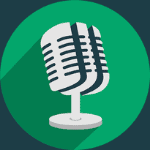Ready to start a podcast?
Audio quality is clearly one of the most important factors – and for that, you’ll need a good microphone.
As you add more people, you will need some additional gear to get everything hooked up and recorded on your computer. It’s not complicated – and I’ll tell you exactly what you need to get started.
I’ll give a lower budget (but quality) recommendation and some suggested upgrade options as well.
Get The PDF Guide: Best Podcast Starter Kits (for any budget)
–> Click Here To Download The Starter Kit Guide.
You’ll get a simplified & straight-forward guide for easy access anytime.
For recording software, just use GarageBand if you have a Mac or Audacity (for Mac & PC). They’re both free recording and editing software. If you have an Adobe Creative Cloud subscription, you can use Adobe Audition, but there’s no need to pay extra for it to start. Also, see this post for remote recording platforms.
You will also need a place to host your recorded MP3 files. I recommend Buzzsprout podcast hosting (use this link for a free $20 Amazon gift card). It comes with free podcast statistics and great support (it’s what I use).
You don’t need to do it to first launch your podcast, but I recommend you get your own website host (separate from the podcast host) so that you have complete control over your everything: design, speed, email sign-ups, etc.
If you don’t want a slow website, check out Kinsta ($30/mo) or Bluehost ($3.95/mo + a free domain name). Don’t forget to get your own domain name!
Buzzsprout will provide you with your podcast RSS feed that you will submit to iTunes, Google Podcasts, Stitcher, etc. Also, take a look at the podcast distribution guide for info on getting more listeners.
Now on to the podcast starter kit recommendations:
1 Person Podcast Starter Kit
Entry Level Option
 | Audio-Technica ATR2100x-USB
| VIEW ON AMAZON → |
 | Audio-Technica ATH-M30x
| VIEW ON AMAZON → |
Ready to start a solo podcast? Here’s what you need:
Seriously, that’s it.
This is the Audio-Technica ATR2100x-USB. Even Tim Ferriss uses this mic. It has both USB and XLR plugs so you can start by plugging it straight into your computer. Later on, you can look into getting a mixer or audio interface.
It also has a headphone jack so you will be able to hear yourself recording. You’ll also want a decent pair of closed-back headphones. The Audio-Technica ATH-M30x headphones are my favorite budget choice.
Feel free to check out the ATR2100 review for the recommended shock mount (to reduce vibrations) and a few more details.
Intermediate Option
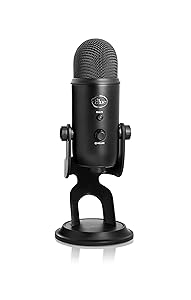 | Blue Yeti USB Microphone
| VIEW ON AMAZON → |
 | Blue Radius II shock mount
| VIEW ON AMAZON → |
 | Heil PL2T boom
| VIEW ON AMAZON → |
Blue Yeti USB Microphone – USB only, but has a ton of features and great sound quality. This is what I started with and it’s extremely popular for good reason. For a 1 person podcast, a quality USB mic is a great choice.
I paired it with the Blue Radius II shock mount and Heil PL2T boom
(cheaper booms aren’t strong enough for the weight of the Yeti).
Intermediate+ Option
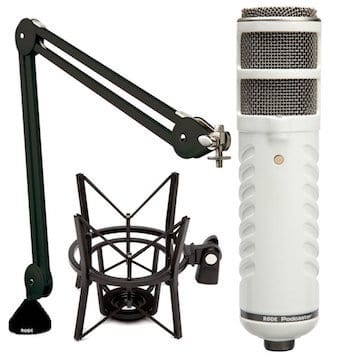 | Rode Podcaster Booming Kit
| VIEW ON AMAZON → |

Rode Podcaster Booming Kit: Podcaster, PSA1 Arm, and PSM1 shock mount – Rode is a well-respected brand in the microphone and audio equipment space and they make awesome stuff. This is a USB microphone so you can be up and running in minutes – without needing extra gear.
Pro Option
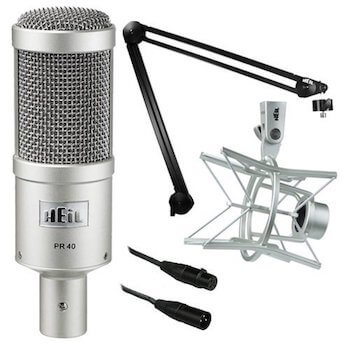 | Heil Sound PR 40
| VIEW ON AMAZON → |
 | Focusrite Scarlett 2i2 (2nd Gen)
| VIEW ON AMAZON → |
 | Heil Windscreen
| VIEW ON AMAZON → |
 | Audio-Technica ATH-M50x Headphones
| VIEW ON AMAZON → |

Heil PR-40 Microphone, Heil PL-2T Boom Arm & Heil PRSM Shock Mount – Broadcast-quality microphone that is nearly unanimously recommended by the pros. This is the best podcast starter kit that comes with nearly everything you need, but you still need a way to connect it to your computer.
Get the Focusrite Scarlett 2i2 (2nd Gen) USB Audio Interface to accomplish that task. Round it out with the Heil Windscreen and the Audio-Technica ATH-M50x Headphones. This stuff will be with you for many years and is worth the investment.
2, 3 & 4 Person Podcast Starter Kits
Entry Level Option
With a 2 or more person podcast, you’ll each need an XLR microphone – and studio headphones are highly recommended. Because you can’t easily record more than 1 USB microphone into one computer, you’ll need a USB audio interface or mixer with at least as many XLR microphone inputs as you have hosts. But also consider having a spare input for a guest!
For the multi-person budget podcast kit I’m going to recommend:
 | Behringer Ultravoice Xm8500 Microphone
| VIEW ON AMAZON → |
 | On Stage Foam Windscreen
| VIEW ON AMAZON → |
 | CBI MLC20 Low Z XLR Microphone Cable (20ft)
| VIEW ON AMAZON → |
 | Audio-Technica ATH-M30x
| VIEW ON AMAZON → |
The Audio-Technica ATH-M30x headphone recommendation stays the same as the single-host kit.
Just get 2x, 3x or 4x of those 4 things.
You will need a way to plug in multiple pairs of headphones though – and the Behringer HA400 is your solution. Don’t forget a balanced TRS cable (different lengths available) to plug it into your mixer or interface.
The USB interface or mixer will depend on how many people you have:
- 2 XLR inputs: Focusrite Scarlett 2i2 (2nd Gen) USB Audio Interface
- 4 XLR inputs:
- Mixer: Behringer Xenyx Q1202USB
- USB Interface: Tascam US-4×4
- 6 XLR inputs:
- Mixer: Behringer Xenyx X1222USB
- USB Interface: Tascam US-16X08
Important: The above mixers don’t have multi-track output to your computer, meaning you won’t be able to edit each person individually. Choose a USB interface if you need this.
Don’t forget you will want extra inputs at some point. Be sure to take a look at the intermediate options for these as the price doesn’t jump that much but the quality does.
So to review you will need:
- Microphone (for each person)
- XLR Cable (for each person)
- USB Interface or Mixer (w/ USB in/out)
Technically optional but highly recommended (for each person):
- Microphone Stand (here are the best tabletop mic stands)
- Shock Mount
- Windscreen or Pop Filter
- Studio Headphones
Here are some upgrade options… feel free to mix and match!
Intermediate Option
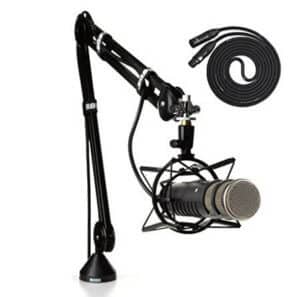 | Rode Procaster
| VIEW ON AMAZON → |
 | Audio-Technica ATH-M50x Headphones
| VIEW ON AMAZON → |
All-around excellent choices that balance price and quality.
Microphone, Boom & Shock Mount
Rode Procaster, Rode PSA 1 Boom Arm, and Rode PSM 1 Shockmount
The Procaster is a big step up from the beginner multi-person kit and is an excellent value for the price.
Headphones
Audio-Technica ATH-M50x Headphones
Audio Interface/Mixer
- 2 XLR inputs:
- Mixer: Yamaha AG06 (only channel 1 has phantom power)
- USB Interface: Focusrite Scarlett 6i6
- 4 XLR inputs:
- Mixer: Mackie ProFX8v2 or RODEcaster Pro
- USB Interface: PreSonus STUDIO 68
- 6+ XLR inputs:
- Mixer: Mackie ProFX12v2
- USB Interface: Focusrite Scarlett 18i20 (2nd Gen)
Pro Option
 | Heil Sound PR 40 Bundle
| VIEW ON AMAZON → |
 | Shure SM7B
| VIEW ON AMAZON → |
 | Electro Voice RE-20
| VIEW ON AMAZON → |
 | Electro-Voice 309A shock mount
| VIEW ON AMAZON → |
 | Heil PL-2T Scissor Boom Arm
| VIEW ON AMAZON → |
 | Shure SRH940 Headphones
| VIEW ON AMAZON → |
If you jumped to here, the microphone kit is the same as the solo section (with other top-notch options as well). The Universal Audio interfaces are fairly expensive, but you can safely use a less expensive model (like from the intermediate section right above here) with the other gear recommendations.
Microphone, Boom & Shock Mount
Heil PR-40 Microphone, Heil PL-2T Boom Arm & Heil PRSM Shock Mount (all in one kit)
Microphone & Shock Mount
- Shure SM7B (shock mount is built in – you just need a boom arm)
- Electro Voice RE-20 (broadcasting classic) & Electro-Voice 309A shock mount (also fits the Heil PR-40)
Because all of these dynamic mics are known to be quiet, I highly recommend pairing them with the CL-1 Cloudlifter (for each mic). It converts phantom power into a very clean +25dB gain. Cloud Microphones has a CL-2 (2 mics) and rack mountable CL-4 model as well.
Boom Arm
Headphones
Shure SRH940 Headphones (probably overkill for podcasting, but they’re really nice either way)
Audio Interface/Mixer
- 2 XLR inputs: Universal Audio Apollo Twin USB
- 4 XLR inputs:
- Mixer: RODEcaster Pro
- USB Interface: Focusrite 18i8 (2nd Gen)
- 6+ XLR inputs:
- Mixer: Allen & Heath ZED-12FX
- USB Interface: MOTU 8pre USB
Let me know in the comments if you have any questions or if you have your own starter kit recommendations. Lastly, podcasting should be fun, so don’t take yourself too seriously!
